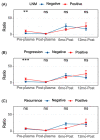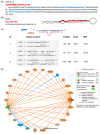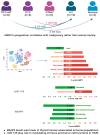Matrix Metalloproteinase 9/microRNA-145 Ratio: Bridging Genomic and Immunological Variabilities in Thyroid Cancer
- PMID: 38001954
- PMCID: PMC10669161
- DOI: 10.3390/biomedicines11112953
Matrix Metalloproteinase 9/microRNA-145 Ratio: Bridging Genomic and Immunological Variabilities in Thyroid Cancer
Abstract
Matrix metalloproteinase 9 (MMP9) and microRNA-145 (miR-145) have emerged as essential biomarkers in thyroid cancer progression and metastasis. However, their combined evaluation and clinical utility as a unified prognostic marker across diverse thyroid cancer subgroups remain unexplored. We investigated the diagnostic and prognostic value of the MMP9/miR-145 ratio in thyroid cancer, hypothesizing it may overcome inter-patient heterogeneity and serve as a versatile biomarker regardless of genetic mutations or autoimmune status. MMP9 and miR-145 expressions were analyzed in 175 paired papillary thyroid cancer (PTC) and normal tissues. Plasma levels were assessed perioperatively and longitudinally over 12-18 months in 86 matched PTC patients. The associations with clinicopathological parameters and patient outcomes were evaluated. MMP9 was upregulated, and miR-145 downregulated in cancer tissues, with a median MMP9/miR-145 ratio 17.6-fold higher versus controls. The tissue ratio accurately diagnosed thyroid malignancy regardless of BRAF mutation or Hashimoto's thyroiditis status, overcoming genetic and autoimmune heterogeneity. A high preoperative circulating ratio predicted aggressive disease features, including lymph node metastasis, extrathyroidal extension, progression/relapse, and recurrence. Although the preoperative plasma ratio was elevated in patients with unfavorable outcomes, it had limited utility for post-surgical monitoring. In conclusion, the MMP9/miR-145 ratio is a promising biomarker in PTC that bridges genetic and immunological variabilities, enhancing preoperative diagnosis and prognostication across diverse patient subgroups. It accurately stratifies heterogenous cases by aggressiveness. The longitudinal trends indicate decreasing applicability for post-thyroidectomy surveillance. Further large-scale validation and protocol standardization can facilitate clinical translation of the MMP9/miR-145 ratio to guide personalized thyroid cancer management.
Keywords: BRAF; MMP9/miR-145 ratio; PTC; biomarker; perioperative assessment; thyroid cancer.
Conflict of interest statement
The authors declare no conflict of interest.
Figures











Similar articles
-
Dynamic monitoring of circulating microRNAs as a predictive biomarker for the diagnosis and recurrence of papillary thyroid carcinoma.Oncol Lett. 2017 Jun;13(6):4252-4266. doi: 10.3892/ol.2017.6028. Epub 2017 Apr 11. Oncol Lett. 2017. PMID: 28599426 Free PMC article.
-
Potential relationship between Hashimoto's thyroiditis and BRAF(V600E) mutation status in papillary thyroid cancer.Head Neck. 2016 Apr;38 Suppl 1:E1019-25. doi: 10.1002/hed.24149. Epub 2015 Jul 18. Head Neck. 2016. PMID: 26041461
-
Association between diffuse lymphocytic infiltration and papillary thyroid cancer aggressiveness according to the presence of thyroid peroxidase antibody and BRAFV600E mutation.Head Neck. 2018 Oct;40(10):2271-2279. doi: 10.1002/hed.25327. Epub 2018 Jun 22. Head Neck. 2018. PMID: 29935011
-
MicroRNA-146b: A Novel Biomarker and Therapeutic Target for Human Papillary Thyroid Cancer.Int J Mol Sci. 2017 Mar 15;18(3):636. doi: 10.3390/ijms18030636. Int J Mol Sci. 2017. PMID: 28294980 Free PMC article. Review.
-
Papillary Thyroid Cancer and Hashimoto's Thyroiditis: An Association Less Understood.Indian J Surg Oncol. 2014 Sep;5(3):199-204. doi: 10.1007/s13193-014-0325-4. Epub 2014 Jul 4. Indian J Surg Oncol. 2014. PMID: 25419066 Free PMC article. Review.
Cited by
-
Vasopressors against post-spinal anesthesia hypotension.J Anesth. 2024 Dec;38(6):891-892. doi: 10.1007/s00540-024-03375-9. Epub 2024 Jul 9. J Anesth. 2024. PMID: 38980401 No abstract available.
-
A quantum-optimized approach for breast cancer detection using SqueezeNet-SVM.Sci Rep. 2025 Jan 25;15(1):3254. doi: 10.1038/s41598-025-86671-y. Sci Rep. 2025. PMID: 39863687 Free PMC article.
References
-
- Issa P.P., Omar M., Buti Y., Issa C.P., Chabot B., Carnabatu C.J., Munshi R., Hussein M., Aboueisha M., Shama M., et al. Hashimoto’s Thyroiditis Minimizes Lymph Node Metastasis in BRAF Mutant Papillary Thyroid Carcinomas. Biomedicines. 2022;10:2051. doi: 10.3390/biomedicines10082051. - DOI - PMC - PubMed
Grants and funding
LinkOut - more resources
Full Text Sources
Research Materials
Miscellaneous

